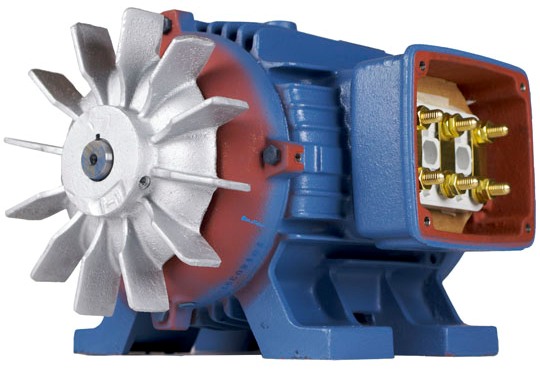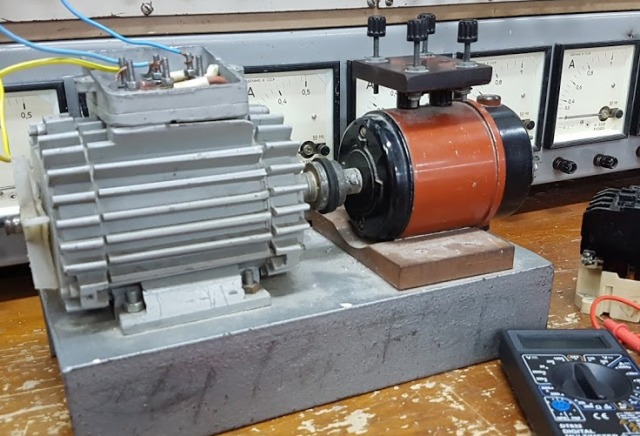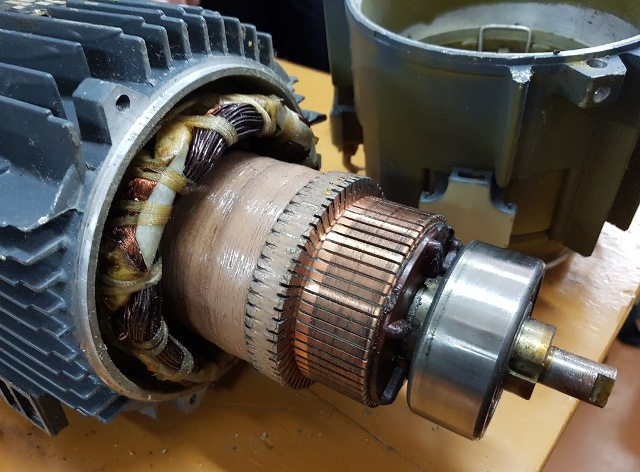Categories: Novice electricians, Electric motors and their application
Number of views: 15594
Comments on the article: 0
How to distinguish an induction motor from a DC motor
Asynchronous motors are motors in the process of operation of which a sliding phenomenon is observed under load, that is, a “lag” of the rotor rotation from the rotation of the stator magnetic field. In other words, the rotation of the rotor does not occur synchronously with the rotation of the stator magnetization, but asynchronously with respect to this movement. That is why these types of motors are called asynchronous (non-synchronous) motors.

In most cases, pronouncing the phrase “asynchronous motor”, they mean the brushless AC motor. The slip value of an induction motor can be different depending on the load, as well as on the power parameters and the method of controlling the stator winding currents.
If we are dealing with a conventional AC motor, such as AIR712A, then with a synchronous frequency of rotation of the magnetic field of 3000 rpm, under conditions of a nominal mechanical load on the shaft of 750 watts, we will have a real speed of 2840 rpm, which means the slip amount is 0.053.
This is normal for an induction motor. AND on the reference plate we will not see round numbers of revolutions, like 3000 or 1500, instead of them 2730 or 1325 will be indicated there. Instead of 1000, for example, 860 can be written, despite the fact that the magnetic field rotates at 1000 revolutions per minute while the engine is running, as should be in an electric machine with 3 pairs of magnetic poles, designed to be supplied with alternating current with a frequency of 50 Hz.

As for direct current motors, in most cases this is the name of collector motors, whose rotor speed is affected not by the current frequency, but by its average value. A speed sensor can help the electronic control system establish the correct current value to obtain a given rotation speed, however, the relationship between current and speed will not be linear here, since at different loads currents of different sizes will give very different rotor speeds.
A multi-section field winding or permanent magnets may be located on the rotor of a DC motor. But today, a rotor with magnets is more typical for stepper motors, which also relate to DC motors, but they do not have collector-brush assemblies. As a variant of the DC motor design, there are magnets on the stator, and the winding on the rotor.

One way or another, the asynchronous brushless motor has a powerful working winding on the stator, which during operation is heated from the passage of the working current through it, and transfers heat to the motor housing. Therefore, the winding and motor housing must be actively cooled all the time.
Due to this feature, most induction motors by default have fan impellers on their shafts, and protrusions on their bodies along which the fan drives fresh air through a radiator, thus cooling the stator. Therefore, if you have in front of you an engine with a fan installed on its shaft (usually under a cover mounted on the engine case), there are fins along the case (like on a radiator), and the nameplate indicates the specific RPM and AC voltage values 220/380 - This is a typical AC induction motor.

In DC motors, with collector-brush assemblies and with multi-section multi-turn windings on anchors, displayed on the collector lamellas, both the stator winding and the rotor winding (anchor) act as working windings.
It actually turns out that the working winding is somehow divided into two parts: the working current flows through the armature winding and through the stator winding, so there is no problem of heating only the stator, and the fan is not needed here.
For cooling, enough ventilation holes through which you can see the rotor with the anchor winding on it. Therefore, if you have an engine with a collector-brush assembly, where the collector has many lamellas (shiny plates) with leads from the windings, and a fan, as it were, it is not provided for - you have a direct current motor.
The stator of a DC motor can be a set of permanent magnets. Most DC motors rated for mains voltage will easily operate on alternating current (an example of such a universal motor is the Bulgarian motor).
See also at i.electricianexp.com
:
